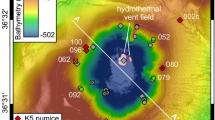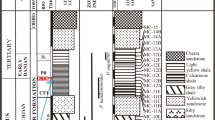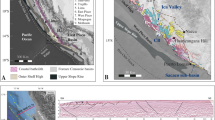Abstract
The geochemistry and paleogeography of the Doushantuo succession in the Shennongjia area have been insufficiently studied. Here, we report on the carbon and oxygen isotope compositions of Ediacaran Doushantuo cap carbonates from four sections (Longxi, Muyu, Yazikou and Songluo) in the Shennongjia area. A large C-isotopic gradient (~5‰) between the Longxi and Songluo sections, here identified for the first time, is inferred to have been dynamically maintained by photosynthesis in surface waters and anaerobic oxidation of dissolved organic carbon (DOC) in deep waters. Spatial variation in C-isotope chemostratigraphy among the four sections was related to Marinoan post-glacial sea-level elevation changes. At Longxi, a positive δ 13Ccarb shift below the horizon containing tepee-like structure resulted from intense photosynthesis during early regression. A negative δ 13Ccarb shift within the tepee-horizon was triggered by sulfate reduction and freshwater mixing with 13C-depleted dissolved inorganic carbon (DIC) during late regression. A positive δ 13Ccarb excursion in the uppermost part of the cap carbonate was related to enhance primary productivity and organic matter burial during early transgression. At Muyu, the carbon isotopic variation tendency, which is similar to that at Longxi, may have been mildly influenced by the surface water environment. At Songluo, the positive δ 13Ccarb excursion, up to -4‰ in the lower part of the cap carbonate, was probably associated with methanogenesis in deep waters during late transgression to early regression and subsequently disappeared due to decomposition of methane hydrate during late regression. At Yazikou, the consistently stable δ 13Ccarb values around -4‰ indicate that the cap carbonate may have deposited at intermediate water depths. As evidenced by diagnostic sedimentary characteristics of the study sections, the palaeogeographic framework of the Shennongjia area exhibited deepening from SE to NW during the Early Ediacaran Period in the aftermath of Snowball Earth.
Similar content being viewed by others
References Cited
Ader, M., Macouin, M., Trindade, R. I. F., 2009. A Multilayered Water Column in the Ediacaran Yangtze Platform? Insights from Carbonate and Organic Matter Paired δ 13C. Earth and Planetary Science Letters, 288(1): 213–227
Broecker, W. S., Peng, T. H., 1982. Tracers in the Sea. Eldigio Press, Palisades, New York. 690
Calver, C. R., 2000. Isotope Stratigraphy of the Ediacarian (Neoproterozoic III) of the Adelaide Rift Complex, Australia, and the Overprint of Water Column Stratification. Precambrian Research, 100(1–3): 121–150. doi: 10.1016/s0301-9268(99)00072-8
Deuser, W. G., 1970. 13C in Black Sea Waters and Implications for the Origin of Hydrogen Sulfide. Science, 168(3939): 1575–1577. doi: 10.1126/science.168.3939.1575
Gao, S., Ling, W., Qiu, Y., et al., 1999. Contrasting Geochemical and Sm-Nd Isotopic Compositions of Archean Metasediments from the Kongling High-Grade Terrain of the Yangtze Craton: Evidence for Cratonic Evolution and Redistribution of REE during Crustal Anatexis. Geochimica et Cosmochimica Acta, 63(13–14): 2071–2088. doi: 10.1016/s0016-7037(99)00153-2
Guo, J., Gao, S., Wu, Y., et al., 2014. 3.45 Ga Granitic Gneisses from the Yangtze Craton, South China: Implications for Early Archean Crustal Growth. Precambrian Research, 242(3): 82–95. doi: 10.1016/j.precamres.2013.12.018
Halverson, G. P., Hoffman, P. F., Schrag, D. P., et al., 2005. Toward a Neoproterozoic Composite Carbon-Isotope Record. Geological Society of America Bulletin, 117(9): 1181–1207. doi: 10.1130/b25630.1
Hoffman, P. F., Halverson, G. P., Domack, E. W., et al., 2007. Are Basal Ediacaran (635 Ma) Post-Glacial “Cap Dolostones” Diachronous? Earth and Planetary Science Letters, 258(1–2): 114–131. doi: 10.1016/j.epsl.2007.03.032
Hoffman, P. F., Kaufman, A. J., Halverson, G. P., et al., 1998. A Neoproterozoic Snowball Earth. Science, 281(5381): 1342–1346
Hoffman, P. F., Schrag, D. P., 2002. The Snowball Earth Hypothesis: Testing the Limits of Global Change. Terra Nova, 14(3): 129–155. doi: 10.1046/j.1365-3121.2002.00408.x
Hu, N., 1997a. Petrological Characters and Sedimentary Environment in Middle Proterozoic Shicaohe Formation of Shennongjia, Hubei Province. Geology and Mineral Resources of South China, 2: 54–61 (in Chinese with English abstract)
Hu, N., 1997b. Lithofacies Palaeogeography of Luanshigou Formation of the Middle Proterozoic in Shennongjia Region of West Hubei, China. Journal of Mineralogy & Petrology, 17(1): 58–62 (in Chinese with English Abstract)
Huang, J., Chu, X., Lyons, T. W., et al., 2013. The Sulfur Isotope Signatures of Marinoan Deglaciation Captured in Neoproterozoic Shallow-to-Deep Cap Carbonate from South China. Precambrian Research, 238: 42–51. doi: 10.1016/j.precamres.2013.09.002
Jacobsen, S. B., Kaufman, A. J., 1999. The Sr, C and O Isotopic Evolution of Neoproterozoic Seawater. Chemical Geology, 161(1–3): 37–57. doi: 10.1016/s0009-2541(99)00080-7
James, N. P., Narbonne, G. M., Kyser, T. K., 2001. Late Neoproterozoic Cap Carbonates: Mackenzie Mountains, Northwestern Canada: Precipitation and Global Glacial Meltdown. Canadian Journal of Earth Sciences, 38(8): 1229–1262. doi: 10.1139/cjes-38-8-1229
Jiang, G. Q., Kennedy, M. J., Christie-Blick, N., 2003. Stable Isotopic Evidence for Methane Seeps in Neoproterozoic Postglacial Cap Carbonates. Nature, 426(6968): 822–826. doi: 10.1038/nature02201
Jiang, G., Kaufman, A. J., Christie-Blick, N., et al., 2007. Carbon Isotope Variability across the Ediacaran Yangtze Platform in South China: Implications for a Large Surface-to-Deep Ocean δ 13C Gradient. Earth and Planetary Science Letters, 261(1–2): 303–320
Jiang, G., Kennedy, M. J., Christie-Blick, N., et al., 2006. Stratigraphy, Sedimentary Structures, and Textures of the Late Neoproterozoic Doushantuo Cap Carbonate in South China. Journal of Sedimentary Research, 76(7): 978–995. doi: 10.2110/jsr.2006.086
Jiang, G., Shi, X., Zhang, S., et al., 2011. Stratigraphy and Paleogeography of the Ediacaran Doushantuo Formation (ca. 635–551Ma) in South China. Gondwana Research, 19(4): 831–849. doi: 10.1016/j.gr.2011.01.006
Jiang, G., Wang, X., Shi, X., et al., 2010. Organic Carbon Isotope Constraints on the Dissolved Organic Carbon (DOC) Reservoir at the Cryogenian–Ediacaran Transition. Earth and Planetary Science Letters, 299(1–2): 159–168. doi: 10.1016/j.epsl.2010.08.031
Jiang, G., Zhang, S., Shi, X., et al., 2008. Chemocline Instability and Isotope Variations of the Ediacaran Doushantuo Basin in South China. Science in China Series D: Earth Sciences, 51(11): 1560–1569
Jiao, N. Z., Herndl, G. J., Hansell, D. A., et al., 2010. Microbial Production of Recalcitrant DOC Long Term Carbon Storage. Nature Reviews Microbiology, 8(8): 593–599. doi: 10.1007/s11430-008-0116-2
Kaufman, A. J., Knoll, A. H., 1995. Neoproterozoic Variations in the C-Isotopic Composition of Seawater: Stratigraphic and Biogeochemical Implications. Precambrian Research, 73(1–4): 27–49. doi: 10.1016/0301-9268(94)00070-8
Kennedy, M. J., 1996. Stratigraphy, Sedimentology, and Isotopic Geochemistry of Australian Neoproterozoic Postglacial Cap Dolostones: Deglaciation, δ 13C Excursions, and Carbonate Precipitation. Journal of Sedimentary Research, 66: 1050–1064
Killingsworth, B. A., Hayles, J. A., Zhou, C., et al., 2013. Sedimentary Constraints on the Duration of the Marinoan Oxygen-17 Depletion (MOSD) Event. Proceedings of the National Academy of Sciences, 110(44): 17686–17690. doi: 10.1073/pnas.1213154110
Knauth, L. P., Kennedy, M. J., 2009. The Late Precambrian Greening of the Earth. Nature, 460: 728–732. doi: 10.1038/nature08213
Li, H. K., Zhang, C. L., Xiang, Z. Q., et al., 2013. Zircon and Baddeleyite U-Pb Geochronology of the Shennongjia Group in the Yangtze Craton and Its Tectonic Significance. Acta Petrologica Sinica, 29(2): 673–697 (in Chinese with English Abstract)
Li, Q., Leng, J., 1991. The Upper Precambrian in the Shennongjia Region. Tianjin Science and Technology Press, Tianjin. 354 (in Chinese)
Lu, S. S., Qiu, X. T., Tang, J. J., et al., 2016. The Pb-Pb Isochron Age of the Kuangshishan Formation in Shennongjia Area on the Northern Margin of theYangtze Craton and Its Geological Implications. Earth Science, 41(2): 317–324
Ohno, T., Komiya, T., Ueno, Y., et al., 2008. Determination of 88Sr/86Sr Mass-Dependent Isotopic Fractionation and Radiogenic Isotope Variation of 87Sr/86Sr in the Neoproterozoic Doushantuo Formation. Gondwana Research, 14(1–2): 126–133. doi: 10.1016/j.gr.2007.10.007
Peng Y., Peng Y. B., Lang, X. G., et al., 2016. Marine Carbon-Sulfur Biogeochemical Cycles during the Steptoean Positive Carbon Isotope Excursion (SPICE) in the Jiangnan Basin, South China. Journal of Earth Science, 26(2): 242–254
Plummer, P. S., 1978. Note on the Palaeoenvironmental Significance of the Nuccaleena Formation (Upper Precambrian), Central Flinders Ranges, South Australia. Journal of the Geological Society of Australia, 25(7–8): 395–402. doi: 10.1080/00167617808729049
Qiu, X., Ling, W., Liu, X., et al., 2011. Recognition of Grenvillian Volcanic Suite in the Shennongjia Region and Its Tectonic Significance for the South China Craton. Precambrian Research, 191(3–4): 101–119. doi: 10.1016/j.precamres.2011.09.011
Rose, C. V., Maloof, A. C., 2010. Testing Models for Post-Glacial ‘Cap Dolostone’ Deposition: Nuccaleena Formation, South Australia. Earth and Planetary Science Letters, 296(3–4): 165–180. doi: 10.1016/j.epsl.2010.03.031
Sawaki, Y., Ohno, T., Tahata, M., et al., 2010. The Ediacaran Radiogenic Sr Isotope Excursion in the Doushantuo Formation in the Three Gorges Area, South China. Precambrian Research, 176(1–4): 46–64. doi: 10.1016/j.precamres.2009.10.006
Shen, B., Dong, L., Xiao, S., et al., 2016. Molar Tooth Carbonates and Benthic Methane Fluxes in Proterozoic Oceans. Nature Communications, 7: 1–6. doi: 10.1038/ncomms10317
Shen, B., Xiao, S., Kaufman, A. J., et al., 2008. Stratification and Mixing of a Post-Glacial Neoproterozoic Ocean: Evidence from Carbon and Sulfur Isotopes in a Cap Dolostone from Northwest China. Earth and Planetary Science Letters, 265(1–2): 209–228. doi: 10.1016/j.epsl.2007.10.005
Shen, Y., Zhang, T., Chu, X., 2005. C-Isotopic Stratification in a Neoproterozoic Postglacial Ocean. Precambrian Research, 137(3–4): 243–251. doi: 10.1016/j.precamres.2005.03.004
Shields, G. A., Deynoux, M., Strauss, H., et al., 2007. Barite-Bearing Cap Dolostones of the Taoudéni Basin, Northwest Africa: Sedimentary and Isotopic Evidence for Methane Seepage after a Neoproterozoic Glaciation. Precambrian Research, 153(3–4): 209–235. doi: 10.1016/j.precamres.2006.11.011
Shimura, T., Kon, Y., Sawaki, Y., et al., 2014. In-Situ Analyses of Phosphorus Contents of Carbonate Minerals: Reconstruction of Phosphorus Contents of Seawater from the Ediacaran to Early Cambrian. Gondwana Research, 25(3): 1090–1107. doi: 10.1016/j.gr.2013.08.001
Volkov, I. I., 2000. Dissolved Inorganic Carbon and Its Isotopic Composition in the Waters of Anoxic Marine Basin. Oceanology, 40: 499–502
Wang, H., Li, C., Hu, C., et al., 2015. Spurious Thermoluminescence Characteristics of the Ediacaran Doushantuo Formation (ca. 635–551 Ma) and Its Implications for Marine Dissolved Organic Carbon Reservoir. Journal of Earth Science, 26(6): 883–892. doi: 10.1007/s12583-015-0650-3
Wang, J., Deng, Q., Wang, Z., et al., 2013. New Evidences for Sedimentary Attributes and Timing of the “Macaoyuan Conglomerates” on the Northern Margin of the Yangtze Block in Southern China. Precambrian Research, 235: 58–70. doi: 10.1016/j.precamres.2013.06.003
Wang, J., Jiang, G., Xiao, S., et al., 2008. Carbon Isotope Evidence for Widespread Methane Seeps in the ca. 635 Ma Doushantuo Cap Carbonate in South China. Geology, 36(5): 347–350. doi: 10.1130/g24513a.1
Xiao, S., Bao, H., Wang, H., et al., 2004. The Neoproterozoic Quruqtagh Group in Eastern Chinese Tianshan: Evidence for a Post-Marinoan Glaciation. Precambrian Research, 130(1–4): 1–26. doi: 10.1016/j.precamres.2003.10.013
Ye, Q., Tong, J., Xiao, S., et al., 2015. The Survival of Benthic Macroscopic Phototrophs on a Neoproterozoic Snowball Earth. Geology, 43(6): 507–510. doi: 10.1130/g36640.1
Zhang, S., Zheng, Y., Wu, Y., et al., 2006a. Zircon U-Pb Age and Hf-O Isotope Evidence for Paleoproterozoic Metamorphic Event in South China. Precambrian Research, 151(3–4): 265–288. doi: 10.1016/j.precamres.2006.08.009
Zhang, S., Zheng, Y., Wu, Y., et al., 2006b. Zircon U-Pb Age and Hf Isotope Evidence for 3.8 Ga Crustal Remnant and Episodic Reworking of Archean Crust in South China. Earth and Planetary Science Letters, 252(1–2): 56–71. doi: 10.1016/j.epsl.2006.09.027
Zhao, G., Cawood, P. A., 2012. Precambrian Geology of China. Precambrian Research, 222–223: 13–54. doi: 10.1016/j.precamres.2012.09.017
Zhou, C. M., Tucker, R., Xiao, S. H., et al., 2004. New Constraints on the Ages of Neoproterozoic Glaciations in South China. Geology, 32(5): 437–440. doi: 10.1130/g20286.1
Zhou, C., Bao, H., Peng, Y., et al., 2010. Timing the Deposition of 17O-Depleted Barite at the Aftermath of Nantuo Glacial Meltdown in South China. Geology, 38(10): 903–906. doi: 10.1130/g31224.1
Zhu, M., Zhang, J., Michael, S., et al., 2003. Sinian–Cambrian Stratigraphic Framework for Shallow-to Deep-Water Environments of the Yangtze Platform: An Integrated Approach. Progress in Natural Science, 13(12): 951–960. doi: 10.1080/10020070312331344710
Acknowledgments
This research is supported by State Key R&D project of China (No. 2016YFA0601100) & the international IMBER project, the National Natural Science Foundation of China (Nos. 41472085, 41172102) and China Scholarship Council. We would like to thank Xinjun Wang for carbon and oxygen isotope analysis. We are also grateful to three anonymous reviewers and the editor for their constructive comments and the Prof. Thomas J. Algeo for his valuable reviews. The final publication is available at Springer via http://dx.doi.org/10.1007/s12583-016-0923-x.
Author information
Authors and Affiliations
Corresponding author
Additional information
Guangzhe Wang: http://orcid.org/0000-0002-8831-3751
Jiasheng Wang: http://orcid.org/0000-0003-4202-0344
Rights and permissions
About this article
Cite this article
Wang, G., Wang, J., Wang, Z. et al. Carbon isotope gradient of the Ediacaran cap carbonate in the Shennongjia area and its implications for ocean stratification and palaeogeography. J. Earth Sci. 28, 187–195 (2017). https://doi.org/10.1007/s12583-016-0923-x
Received:
Accepted:
Published:
Issue Date:
DOI: https://doi.org/10.1007/s12583-016-0923-x




